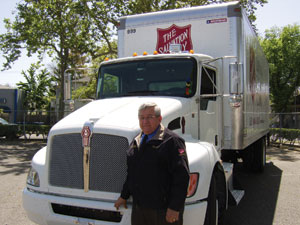the United States serves in 5,000 communities nationwide. Annually, nearly 30 million Americans receive assistance in the form of food for the hungry, relief for disaster victims, assistance for the disabled, outreach to the elderly and ill, clothing and shelter to the homeless and opportunities for underprivileged children.
Behind that broad array of social services is a large fleet of trucks, notes Henry Filoteo, business administrator for The Salvation Army’s Adult Rehabilitation Center (ARC) in Sacramento, Calif., and the organization’s western territorial director of production. The western fleet operation, headquartered in Long Beach, Calif., encompasses the area from Colorado to Hawaii and operates 350 vehicles from 22 locations.
Taking steps
“We have 230 trucks in California alone,” Filoteo says. “New regulations issued by the California Air Resources Board (CARB) have propelled us to look closely at our fleet and to find ways to bring it into compliance with emissions standards. At the same time, we’ve taken steps to address cost and driver issues.
“As a non-profit organization,” Filoteo continues, “we tended to keep capital expenditures down by purchasing used vehicles, mostly groups of trucks that had been turned in at the end of a lease with 30,000 to 40,000 miles on them. That practice, however, proved not to be very cost effective and led to other issues as well.”
One of the problems that buying used vehicles presented for The Salvation Army was the desire to operate equipment for long periods of time. The used equipment did not generally come with any warranty coverage, Filoteo relates, and averaging 30,000 to 35,000 miles per year for 10 to 12 years in the fleet drove up repair costs.
Weighing costs
“With some of the groups of used trucks that we purchased,” Filoteo reports, “we were experiencing 30% failure rates. When you start weighing the cost of keeping older equipment running, it just wasn’t cost effective on a per mile basis. While we can buy used trucks for less up front, the cost of keeping the fleet running is high.”
An investment in new trucks required a large capital expenditure for The Salvation Army, but as Filoteo notes, “we knew the overall cost would be lower. My background in heavy-duty truck repair also taught me that new trucks would be as close to maintenance-free as possible, and that we’d see costs drop from greater long term durability with new equipment.”
As a result, beginning in late 2009, the western Salvation Army fleet has been taking delivery of 54 Kenworth T270 trucks. The first 30 units, which are replacing 2000 and older model year vehicles, are domiciled in San Diego, Riverside and Anaheim, Calif. All of the new trucks have been supplied through NorCal Kenworth, located in the San Francisco Bay area.
Meeting needs
“We chose the Class 6 Kenworths to give us added capacity on our pick up routes for donations,” Filoteo explains. “We could have bought what were essentially heavy-duty pickups for less but felt that the Kenworths were better suited to meet our needs.
“At the same time,” Filoteo continues, “these trucks are a way to help us attract a higher caliber of drivers. In the past, we had high driver turnover. Now, by providing newer equipment, we’re seeing better drivers who stay longer, and a reduction in accident rates.”
Also dropping for The Salvation Army western fleet are maintenance costs. Through NorCal Kenworth, the new T270s will be serviced under Kenworth’s PremierCare maintenance program. Other trucks in the fleet will also be maintained under a contract maintenance program through PremierCare.
“For many years we used a hodgepodge of dealers, independent service locations and on-site service providers to handle our maintenance, repairs and breakdowns,” Filoteo says. “The quality and cost of the work was inconsistent at best, and those arrangements made managing the fleet and budgeting very difficult.
“For more than a year,” Filoteo continues, “we evaluated PremierCare programs in our Oakland and San Jose, Calif., locations. Over a very short period of time, we began seeing savings in maintenance and repair costs. Today, we have nine locations using Kenworth dealers for service, and in those locations the decrease in costs is a minimum of 15%.”
Over the next several months, according to Filoteo, The Salvation Army western fleet will transition about two of its locations monthly to PremierCare maintenance programs. Plans also call for all of the organization’s 22 fleet locations in its western territory to be converted to the program by the fall of this year.
Higher quality
“With this arrangement,” Filoteo states, “we are receiving higher quality and more consistent maintenance and repair services. In addition, with guaranteed pricing, we are able to resolve budgeting issues, along with lowering operating costs for the fleet.”
Dealing with one central organization to meet vehicle and maintenance needs is also providing Filoteo with the time he needs to manage both the western Salvation Army fleet and the organization’s Sacramento center.
“The main thing,” Filoteo says, “is that the long standing reputation of The Salvation Army is better served by a fleet of newer, safer and more cost effective trucks. Without the right equipment and maintenance services, we simply couldn’t meet the goals of our mission to serve.” FE
The Salvation Army Truck Specifications
Model: Kenworth T270
Wheelbase: 260 to 272 in.
Body: Morgan, aluminum, 24- to 26-ft.
Lift Gate: Interlift ILP-33, dual cart stops
Engine: PACCAR PX 6; 200 HP, 520 lb./ft.
Transmission: Allison 2500 HS, five-speed automatic
Front Axle: Dana Spicer, 10,000-lb. capacity
Rear Axle: Dana Spicer P22060S, 16,000-lb. capacity
Wheels: Accuride; 22.5-in. steel disc
Tires: Bridgestone 11R22.5; R250F
Seats: Kenworth Air Cushion Plus driver; two-person bench passenger
Fuel Tank: Aluminum, 75 gal.
